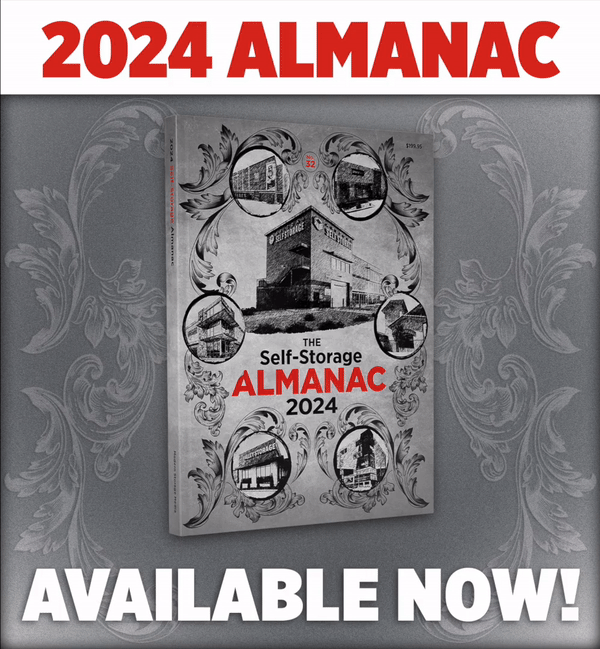New Directions: TLW Construction Forms New Partnership
Over 40 years ago, when the industry was new, Ted Williams formed TLW Construction in Gilbert, Ariz., with a focus on building self-storage. After working as a CPA for several years, he found an interest in construction and became a general contractor in 1981, primarily building homes. Some friends asked Ted to build a 35,000-square-foot storage facility, and soon TLW found a niche in storage construction.
“The industry was still very small,” Ted says. “It was all single-story drive-up.” He says financing was tough because banks didn’t understand self-storage. Ted began building one or two facilities yearly and gained a reputation as someone who operated with integrity. His business philosophy was based on values he considers important.
“Honesty and fairness,” Ted says. “To me, fairness is a higher level. You can be honest and still treat someone unfairly. Also, I wanted to build something I was proud of. I didn’t care what it took to get that done.”
As both the industry and the company were growing, changes came in 2001 when Ted’s wife was struggling with a terminal illness. His son, Tarik, who had just graduated with a B.S. in construction management from Arizona State University, agreed to run the daily operations so his father could focus on matters at home.
Changing Times
In addition to computerizing the company, he instituted a document control system. “There was no contract,” Tarik explains. “My dad did all of his business with a handshake.” But the business world had changed, and Tarik felt the company needed better protection and better documentation for clients. He also instituted a safety program and a marketing program that included trade shows and print advertising.
Although Tarik previously had no interest in partnering with his father at TLW, his involvement would steer the future direction of the company. He had graduated at the top of his class just a few months after 9/11. Typically, Tarik would have enjoyed several offers from large construction companies, but the economic uncertainty caused by the 9/11 attack meant that no one was hiring.
“I looked at my dad’s company and realized the colossal untapped potential with what he had built with his hard work and honesty,” he says. Combining the reputation his father had earned with Tarik’s skills, the company was poised for success. “I had more of a marketing mind and entrepreneurial mind and skillsets I had developed through some internships in college with big national construction companies. We ended up partnering and grew the company.”

He also had an internship with a multi-million- dollar construction business and saw how a very large company organized their daily tasks and documentation. Tarik built TLW’s processes based on what he had seen. “You have to be a constant student of everything,” he says. “You need to be sponging up everything you can from every person you rub shoulders with, every business you come into contact with.”
With a stable business model in place, Tarik could draw on the company’s reputation and point to successful projects they had completed. In addition to these advantages, his father had instilled in his eight children the importance of a strong work ethic. “I was tying steel for tilted concrete walls when I was six or seven years old,” Tarik says. “My dad would bring home that steel and pay us for piece work. I was also sweeping out storage units at age 10 or 11.”
Instead of transitioning into a leadership position, Tarik had to be in charge from day one. He worked without a salary the first year while paying off debt. The economy was getting back on track and suddenly, Tarik had several job offers from other companies. However, he saw a promising future for the company his dad had founded. “My life would have taken a different path if not for 9/11,” he says.
Recession Woes
One of the changes TLW made was to add Caliber Metal Buildings to its portfolio in 2006. “It was bogging us down waiting for suppliers,” Tarik says. “So, we decided to produce our own.”
Then, around 2008, the Great Recession hit, bringing the building boom to a jarring halt. “We were sitting on about $40 million in signed contracts that evaporated overnight,” Tarik recalls. “We were at a meeting in Santa Fe, N.M., ready to start a project. The bank president didn’t come in, so we waited. After nearly an hour, he came in looking white as a ghost. He said, ‘This Lieman Brothers thing has happened, and we can’t fund this project. We can’t do anything. Sorry.’ Then he walked out.”
That was just the beginning, Tarik says. Within the next month, every project in TLW’s pipeline had fallen apart. “It was the beginning of a very long and challenging timeframe in the construction and development world,” he says. “I think a lot of people who had been very successful had to fold. This went on for many years.”
Again, Tarik would go for years without a paycheck while the company recovered. He went back to selling real estate to make ends meet. “Everything I had done professionally to that point had turned to gold,” he says. “It was a depressing time. Coming out of that, it was almost back to the bare bones. I’d get out in the field to work with the guys. It was a great time to be humble, to see what worked and what didn’t work during those good years, and to build back the business.”


Design/Build Trends
He says, after extensive study, some developers are finding that a return to simple drive-up storage, or at least including as many drive-up units as possible in overall site usage, is the most profitable direction for their development goals.
“Construction costs are driven by land cost, land improvement cost, design cost, building size and type, and technology cost,” he says. “With simple drive-up storage, 100 percent of building construction costs and dimensions goes to net rentable units.” In contrast, he notes that with climate-control units, approximately 25 percent of the building area is lost to hallways and other space that will never collect rent.
“Construction costs tend to be less in drive-up units when compared to climate control by maybe 15 to 30 percent, depending on the complexity of the multistory, climate-control building,” Tarik says. “When factoring in the lost square footage built to net square feet of rentable space, the proportional added cost of climate control is more like 40 to 55 percent.”
He says that in many markets, particularly in areas of higher rents and lower land availability, drive-up units fetch equal or even higher rental rates than climate control, and they rent up more quickly. “Most markets will see climate-control units collect 15 to 25 percent more in rent than drive-ups,” Tarik says, “but this does not make up for the added proportional costs noted above.”
However, he says climate-control units will continue to be built, partly due to demand for them but also due to restrictive city codes and high land costs in urban markets.
Though the basic storage approach can be the most profitable option for some projects, Tarik says demand is still there in some markets for top-of-the-line facilities. “At the other end of the spectrum, there are developers who have found incredible value in the finest exterior and interior building finishes, expansive lush offices with coffee bars and play areas, inclusion of Bluetooth access control to gates and units, dozens of high-power cameras, and online rental capability,” he says.

New Directions
“Tarik was TLW Construction,” Ted says. “If something happened to him, TLW would have died. He came to me and said he wanted to partner with critical individuals so that the whole company wasn’t just him.” Ted agreed to sell his share to three others.
“I call them the three legs of the stool,” Tarik says. With Tarik as president, the new owners are Curtis Ryan, vice president of finance; Devan Williams, vice president of preconstruction; and Blake Pfaff, vice president of construction.
Devan is the youngest of Ted’s sons and came to work at TLW as an intern while earning a degree in construction management. “I worked my way up to project engineer and then to project manager,” he says, adding that he’s proud to carry on the company his father founded. “A lot of people in the industry respect my dad,”
Devan says. “The key thing we learned from him was work ethic. All my life, I watched his example of how to work and how to take care of what you are responsible for.”
Devan’s goal is to help provide steady growth and stabilization for the company. “We’re working to continue in the legacy my dad built, and that Tarik has had a big hand in,” he says. “A stable company that people can rely on.”

Ryan, a CPA, came to TLW shortly after Tarik came in. He worked as the company’s controller for two decades. The company now has 25 employees and Ryan says the new setup is structured so that it will be easy to scale up when necessary.
Rising costs and labor shortages during the pandemic caused some projects to be put on hold; however, he says the company has weathered it well. Ryan says rising interest rates have also caused some slow down, “but with self-storage, deals are usually not lost but just put on hold.” He is looking forward to seeing TLW grow. “I have nothing but good things to say about the company and the team,” Ryan adds.
TLW Construction builds all storage types, including single-story, multistory, climate control, RV and boat, facility expansions, conversions, and renovations. The company is experienced in using a full range of construction materials including tilted concrete, masonry, and all types of metal.
Since design flaws can be costly, both in time and money, TLW works with architects and engineers to bring their experience and knowledge during the planning and design phase and to promote cost and time efficiency in design and construction.
With a new project underway in Texas and more in the works, the company is expanding into other Southwest markets. However, Arizona remains TLW’s primary market, where Tarik serves on the board of directors of the Arizona Self-Storage Association. He has also authored several articles in industry publications and has been a keynote speaker at industry conventions.
In addition to the values on which his father built TLW Construction, Tarik has followed some of his own principles that continue to guide him during the industry’s ups and downs. “Don’t quit,” he says. “Take responsibility. Be nimble.”

More Content
Popular Posts
The self storage industry is in a precarious...
Like its name implies, Surprise, Ariz., a...
Joe Shoen, CEO of U-Haul, has had enough.
Joe Shoen has had enough.
In a record-breaking deal finalized May 12,...
Senate Bill 709 (SB709) has many in the...
Donald Trump has just reclaimed the White...
Self-storage operators wear a lot of hats....
The question of “abandonment” of stored...
In 1992, Clinton strategist James Carville...
Recent Posts
When Neville Kennard left for a work trip to...
Self-storage software is no longer...
The self-storage industry continues to...
Fires in California. Tornadoes in Kansas....
From policy pivots in Ottawa to tariff...
Self-storage operators have struggled to...
Their signature red coats may draw attention...
Nailing down Josh and Melissa Huff for an...






















